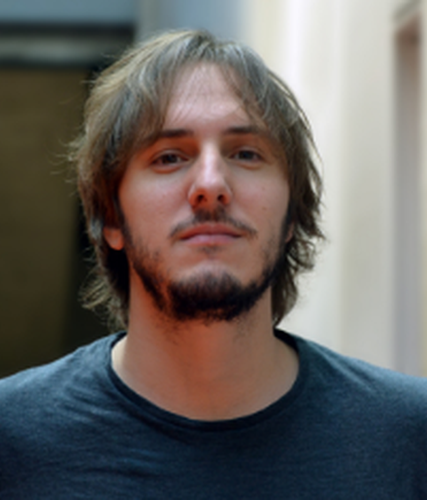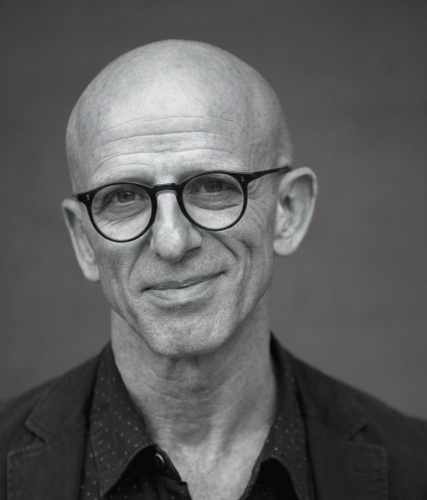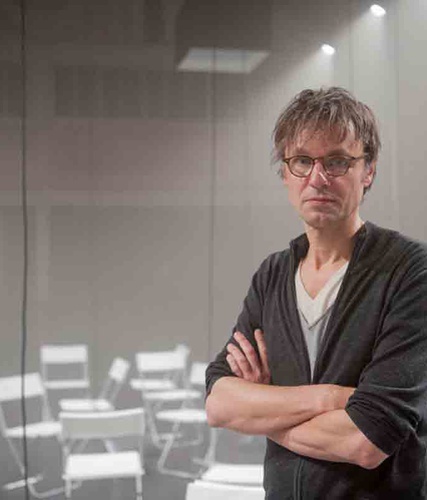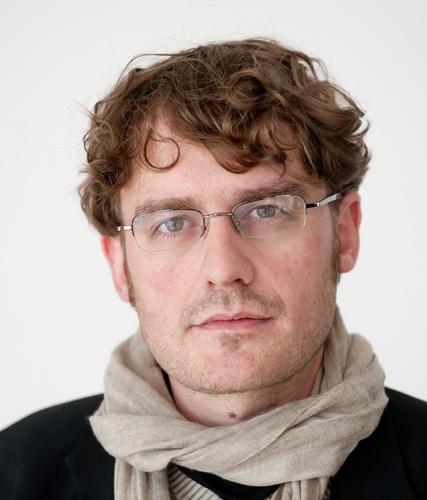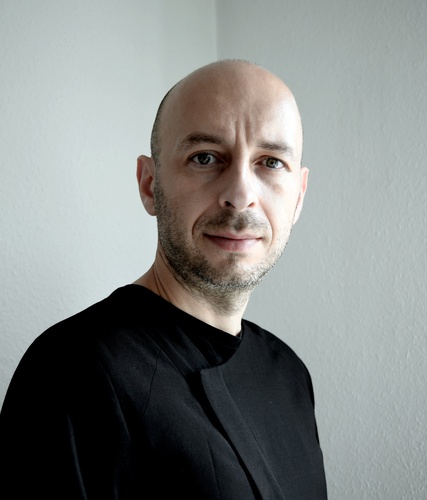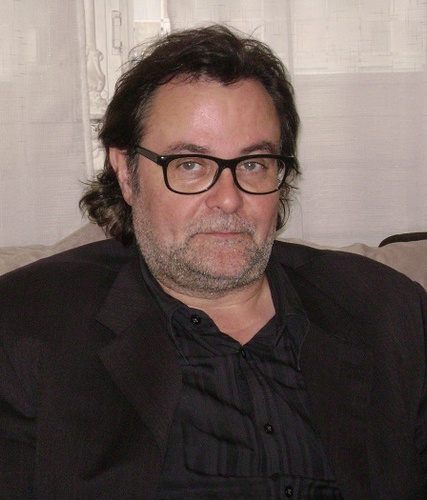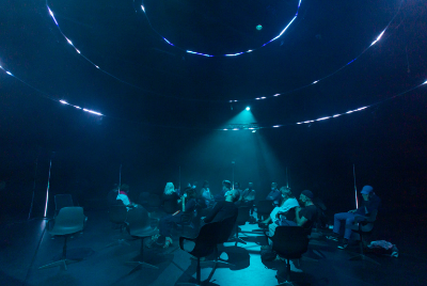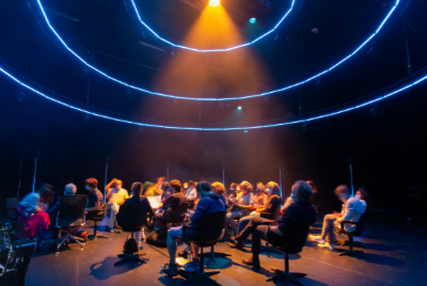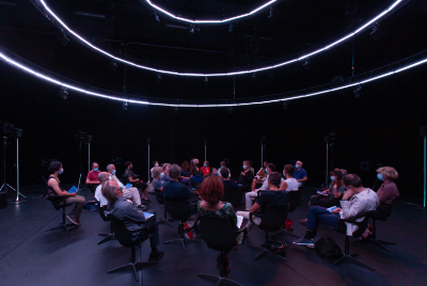Musiques-Fictions
Nous avons rencontré les créateurs des trois premiers opus des Musiques-Fictions, une nouvelle collection de l'Ircam où la création musicale est en prise directe avec la fiction littéraire. Metteurs en scène et compositeurs, ces artistes nous expliquent comment ils ont conçu collectivement ce nouveau format à la croisée des genres et la manière dont ils se sont emparés des dernières techniques de spatialisation sonore, pour créer un espace d'écoute immersif sous le dôme Ambisonique de l'Ircam.
![]()
#1 Naissance d'un pont de Daniele Ghisi et Jacques Vincey, sur un texte de Maylis de Kerangal

« Des espaces vierges à notre sensibilité et notre imaginaire »
Entretien avec Daniele Ghisi et Jacques Vincey
Un livre est normalement écrit pour être lu pour soi, dans sa tête : comment avez-vous abordé le défi de le faire passer au sonore ? L’avez-vous retravaillé, coupé ?
Jacques Vincey : Plutôt que la comparaison, c’est la complémentarité qui m’intéresse : quelle expérience différente de la lecture peut-on proposer ? Comment entrer dans un roman de plus de 300 pages avec nos oreilles plutôt qu’avec nos yeux ? La première étape a été d’adapter l’œuvre pour la rendre compatible avec une écoute de quatre épisodes d’une vingtaine de minutes chacun.
Daniele Ghisi : Le passage s’est réalisé pour moi à travers les acteurs et la mise en voix de Jacques Vincey : mon point de départ, en tant que compositeur, est le texte lu, et non pas le texte abstrait sur la page. Par ailleurs, je ne suis pas complètement convaincu que les livres qu’on lit « silencieusement » soient effectivement si silencieux. La lecture « pour soi » (un phénomène relativement récent par rapport à la lecture tout court) implique en tout cas (du moins pour moi) une certaine imagination des sons. Il y a bien du bruit là-dedans. C’est pourquoi j’ai besoin de silence pour lire. Je n’arrive pas à lire en écoutant de la musique, pour la même raison que je n’arrive pas à écouter de la musique dans un lieu trop bruyant. Bien sûr, ce n’est pas la même chose que de les entendre en vrai mais, quelque part, les sons sont là, mystérieusement, sur la page.
Comment approcher ce nouveau format qui tient du cinéma (un support fixe, que l’on appréhende collectivement), de l’installation et de la pièce radiophonique ?
Ghisi : J’adore ce format, car j’adore le cinéma, l’installation et les pièces radiophoniques !
Je pense qu’une des approches possibles est similaire à celle du Hörspiel – mais l’englobement, le dispositif, et l’aspect installation le rendent beaucoup plus charnel et sensoriel. À la différence du Hörspiel, c’est une musique dont on fait « l’expérience », on ne se contente pas de l’écouter. C’est en tout cas ainsi que j’ai approché le problème. J’aime le fait que ce dispositif peut solliciter des sensations, comme des images sans images, et d’une manière bien plus profonde que de simples bruitages ou qu’un audio-livre avec musique d’accompagnement.
En l’occurrence, il n’y a pas de support visuel, mais il y a le dispositif ambisonique : comment s’emparer de cet outil technologique immersif dans ce cadre ?
Vincey : Le dôme ambisonique mis au point par l’Ircam repousse les bornes du possible, déplace les seuils de perception et ouvre des espaces vierges à notre sensibilité et notre imaginaire. Ce nouveau médium exige de nouvelles pratiques pour pouvoir envisager de nouveaux usages. Notre enjeu est donc d’explorer les pistes qui modifieront nos habitudes de lecteurs, de spectateurs et d’auditeurs. La diffusion à 360° brouille les repères spatiaux tout en accentuant une sensation de réalité : on entend « comme dans la vie » mais on ne peut voir aucune image (« comme au cinéma »). L’écoute est collective et pourtant chacun est renvoyé à sa solitude. L’immersion dans ce nouveau dispositif fictionnel nécessite de s’abandonner à des sensations inconnues pour pouvoir accéder à d’autres représentations mentales et émotionnelles.
Ghisi : L’opportunité donnée par les moyens immersifs de l’ambisonique est fondamentale : il ne s’agit pas, pour moi, d’explorer des trajectoires complexes de sons dans l’espace, mais plutôt d’identifier certains mouvements archétypaux qui peuvent être répétés, pour devenir la « signature spatiale » de chaque épisode. Il s’agit de construire une expérience physique en même temps qu’un voyage littéraire.
Pour le premier épisode de Naissance d’un pont, il s’agit surtout, dès le début, de passages des sons de l’avant vers l’arrière, comme à nous mettre au milieu d’un pont, avec des voitures qui passent à côté de nous ; vers la fin, on perçoit aussi le mouvement de rotation d’une bétonnière (qui sera repris dans les épisodes suivants). D’autres mouvements sont mis en place pour le reste de la série : bascules avant-arrière, montées vers le haut en spirale, chute, etc. Remarquons que l’essentiel des sons qui m’ont servi pour composer ne provient pas d’enregistrement de musique concrète, mais est travaillé à partir d’une grande base de sons au moyen de techniques de composition assistée par ordinateur. En revanche, à certains moments, des « fenêtres » concrètes apparaissent. Tout d’un coup, nous nous retrouvons, pour quelques dizaines de secondes, en plein milieu d’un environnement hyperréel (un réel au microscope ou énormément amplifié). Ce mélange d’abstrait et d’hyper-concret est un autre point important de ma recherche sonore sur cette musique-fiction.
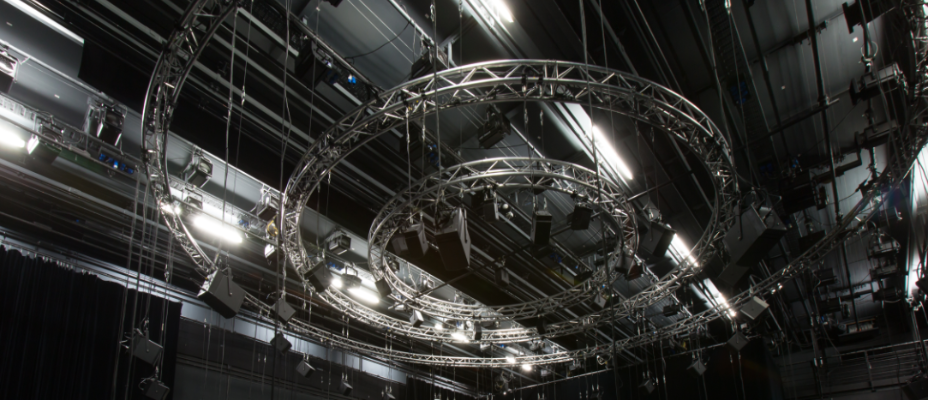
Le dôme ambisonique de l'Ircam © Hervé Veronese
Quel type de collaboration avez-vous engagé au sein de l’équipe ? Quelle articulation entre texte dit et musique ?
Vincey : L’articulation de la musique et de la fiction dans ce dispositif spécifique nous oblige à lier étroitement une réflexion théorique à des expérimentations concrètes et sensibles. Nous cherchons ensemble comment raconter cette histoire sans nous enfermer dans le cadre de la logique narrative et de l’illustration réaliste. Nous travaillons à produire un « souffle » commun pour élargir nos imaginaires respectifs. Le spectre ouvert par la technologie génère des possibles qui doivent cependant être maitrisés : l’auditeur doit disposer de l’espace nécessaire pour élaborer ses propres fictions musicales, au cœur de nos propositions.
Ghisi : Pour des questions pratiques, je n’ai pas pu travailler directement avec les acteurs, ce qui m’a un peu manqué. Le travail avec Jacques a été très agréable : ses remarques ont fait évoluer la partie musicale et le mixage. Nous étions presque toujours d’accord sur les points faibles. Il s’agissait surtout de trouver une ligne de crête entre compréhension du texte et création de quelque chose qui le dépasse. Une expérience au sein de laquelle texte et musique font partie d’un tout. Cela n’est pas évident, surtout avec un dispositif au calibrage si délicat. Sur un ou deux points spécifiques, nos visions divergeaient un peu. C’est bien normal et la tension suscitée fut très positive.
Propos recueillis par Jérémie Szpirglas
![]()
#2 L'Autre fille d'Aurélien Dumont, Daniel Jeanneteau et Augustin Muller, sur un texte d'Annie Ernaux
« Entre l’intimité de la lecture et les débordements de l’imaginaire»
Entretien avec Aurélien Dumont et Daniel Jeanneteau
Un livre est normalement écrit pour être lu pour soi, dans sa tête : comment avez-vous abordé le défi de le faire passer au sonore ?
Aurélien Dumont : Pour élaborer musicalement cet espace mental intime et intériorisé propre à la lecture, j’ai travaillé à partir d’un objet musical minimaliste basé sur l’orchestration d’harmoniques de flûte basse et de violoncelle avec des plaques en fonte. L’association de l’objet trouvé, quotidien, avec une instrumentation particulière construit un repère sonore aisément identifiable et ludique, qui évoque pour moi le monde de l’enfance, l’un des thèmes centraux des magnifiques mots d’Annie Ernaux. L’autre grand thème, celui de l’absence, s’exprime musicalement par la déliquescence de cet objet initial et dans sa transformation en silence habité par la corporéité des interprètes que nous souhaitons, avec Augustin Muller, faire voyager dans différents espaces acoustiques. Les traitements électroniques de la partie instrumentale évoluent principalement au sein de cette dimension spatiale, entre focus précis en close up et construction de paysages sonores plus larges.
L’avez-vous retravaillé, coupé ?
Daniel Jeanneteau :L’autre fille d’Annie Ernaux est un livre court, mais j’ai préféré concentrer la parole sur ce qui, à mes yeux, relevait le plus exactement du travail intérieur de construction, l’effort d’intelligence et de solitude dont elle parle dans le texte. J’ai écarté certaines évocations plus documentaires sur sa famille ou les époques, sans jamais intervenir dans le mouvement d’un paragraphe ou d’une phrase. Puis j’ai soumis ce montage à Annie Ernaux, qui l’a accepté.
Envisage-t-on sa mise en son comme une mise en scène ?
Jeanneteau : La seule mise en scène est de suivre le mouvement de sa pensée, dans la linéarité de la lettre. Annie Ernaux traverse beaucoup d’espaces et de temps différents, de dimensions dans sa conscience. Il s’agit de la suivre, sans jamais la commenter ni chercher à la compléter, mais en ouvrant l’écoute à des sensations qui, selon ses propres termes, ont nourri l’écriture.
Le cas de cette musique-fiction est particulier, parce que le texte est dit par nulle autre que… l’auteure : comment la diriger dans la lecture de son propre texte ?
Jeanneteau : C’était une sorte d’évidence, peut-être simplement parce qu’un tel texte ne peut être interprété, joué dans la distance d’une interprétation. Le faire entendre procède peut-être, encore, du geste de l’écriture, pour autant que ce soit le corps même de l’auteure qui le traverse. Le temps a passé depuis que ce texte a été écrit, qui relate des événements eux-mêmes déjà anciens. C’est apporter un élément nouveau et particulièrement émouvant que de restituer, grâce aux propriétés de la diffusion ambisonique, quelque chose de la présence d’Annie Ernaux à ce moment de son existence, et dix ans après qu’elle ait écrit L’autre fille. Annie Ernaux est par ailleurs une excellente lectrice, tenant à distance ses émotions, les laissant filtrer néanmoins sans que les affects ne viennent peser sur l’expression. C’est un peu comme si elle-même était témoin de son écriture, de son besoin d’interroger par l’écrit la présence en elle de cette sœur jamais connue.
Dumont : C’est un défi en soi. La méthodologie a été de laisser dans un premier temps le geste compositionnel originel en autonomie par rapport à sa voix. En d’autres termes, il s’agissait de puiser dans ma propre lecture du texte le substrat nécessaire à l’élaboration sonore et processuelle de la partition, en discussions suivies avec Daniel. Dans un second temps, le déploiement des esquisses musicales avec l’enregistrement de la voix d’Annie Ernaux a redéfini les contours formels de l’œuvre afin de trouver sensiblement la place de l’un par rapport à l’autre, un équilibre, une juste mise en tension. Pour reprendre le concept de François Jullien de dé-coïncidence, l’idée est davantage de provoquer une rencontre que de vouloir se faire correspondre deux expressions dans un rapport illustratif possiblement inorganique.
Dans ce nouveau format qui tient du cinéma (un support fixe, que l’on appréhende collectivement), de l’installation et de la pièce radiophonique, il n’y a pas de support visuel, mais il y a le dispositif ambisonique : comment s’emparer de cet outil technologique immersif dans ce cadre ?
Jeanneteau : C’est précisément la singularité du dispositif ambisonique qui me guide vers une conception du travail sonore ne correspondant à aucun des domaines que vous citez. Je ne souhaite pas du tout m’approcher du cinéma, et pas davantage de la pièce radiophonique. Les possibilités de spatialisation du dôme permettent d’inventer de nouvelles partitions. Le travail de réalisation, assuré par Augustin Muller en compagnie de Sylvain Cadars, porte essentiellement sur les acoustiques. Je veux utiliser l’une des facultés étonnantes de l’ambisonique qui est de restituer l’acoustique de lieux dont on a pris l’empreinte. Et par le passage insensible d’un espace acoustique à l’autre, affecter la parole d’Annie Ernaux d’un mouvement discret, qui ne détourne pas de l’écoute mais qui l’accompagne, dans l’idée de m’approcher de cette forme de mémoire qui retient, sans mots, la sensation d’un espace ou d’un moment. Augustin a fait des prodiges pendant le confinement pour restituer depuis son appartement les acoustiques que nous cherchions.
Dumont : Dans l’élaboration d’une fiction ambisonique, l’incarnation ne passe pas par la présence physique des interprètes mais par une construction de l’espace qui les fait exister autrement. Cette approche particulière a des incidences sur l’écriture musicale, le dispositif permettant de voyager aisément de l’intérieur du son jusqu’à ses propres projections environnementales. Je pense que le déplacement de la perception est également sensible dans cette œuvre, avec ses propres enjeux de sons, de sens et d’écarts.
L’immersion propre au dispositif ambisonique permet une composition musicale proche de l’introspection. C’est la direction esthétique que semble appeler le texte d’Annie Ernaux, celle sur laquelle repose nos envies communes avec Daniel Jeanneteau. Il ne s’agit donc pas ici de soutenir une action dramatique par une grande densité sonore mais plutôt de proposer de subtiles variations de matériaux et d’espaces acoustiques. Nous souhaitons utiliser cette technologie pour élaborer une œuvre qui s’exprime entre l’intimité de la lecture et les débordements de l’imaginaire.
Quel type de collaboration avez-vous engagé au sein de l’équipe ? Quelle articulation entre texte dit et musique ?
Jeanneteau : Il nous est apparu évident que le travail musical ne pouvait consister en un accompagnement, une garniture qui serait là pour agrémenter le texte. J’ai proposé à Aurélien Dumont de concevoir une musique qui puisse prendre la même place que la parole, qui soit une sorte d’équivalence non verbale de la parole. Et qu’elle s’inscrive dans le mouvement de la pensée, comme l’une de ses parties, sans pour autant, bien sûr, chercher à traduire en musique ce que dit Annie Ernaux. Il s’agit en fait de faire coexister avec l’écriture un autre mode d’intériorité, une respiration qui n’interrompt pas l’effort de formulation, mais le soulage en le déplaçant.
Dumont : Cette collaboration me fait penser à un jeu de construction réalisé à plusieurs mains, où chacun produit son propre matériau que nous imbriquons ensemble, étape par étape. Ce fut pour moi réellement passionnant de travailler avec Daniel et Augustin, d’entendre et d’esthétiser la très touchante voix d’Annie Ernaux. C’est l’écoute qui devient le liant de ce chantier, et qui permet au sens résonnant dont nous parle Jean-Luc Nancy d’advenir comme une articulation possible du texte dit et de la musique.
Propos recueillis par Jérémie Szpirglas
![]()
#3 Bacchantes d'Olivier Pasquet et Thierry Bédard, sur un texte de Céline Minard
« Attenter au sensible »
Entretien avec Olivier Pasquet et Thierry Bédard
Un livre est normalement écrit pour être lu pour soi, dans sa tête : comment avez-vous abordé le défi de le faire passer au sonore ?
Olivier Pasquet : Je ne compose que de la musique purement électronique depuis des années. Je me passionne en effet beaucoup pour les pièces qui ne sont pas interprétées par un instrumentiste et qui arrivent à l’auditeur le plus directement possible. Il réside en moi d’insondables questions de causalité dans la chaîne de transmission de l’information : que faire d’une pièce générative sans début, ni fin, avec une infinité de versions possibles ou parallèles ? Doit-on justement en faire quelque chose ? Doit-on la jouer dans des musées l’après-midi, des salles de concert le soir, des night-clubs la nuit, ou finalement au casque pour soi-même ?
Tout ce qui touche une lecture linéaire chronologique fait donc partie de mes explorations ; en particulier si celle-ci peut se faire intérieurement. Il n’y a rien de plus captivant que de déchiffrer des formes à travers diverses échelles. Le type de concentration active pour cette musique peut aussi prendre la forme d’une narration. C’est par cette prise de forme que le sensible se crée en transformant la formalisation en affect. C’est donc là que se heurtent la musique, le jeu des comédiens et le texte.
L’avez-vous retravaillé, coupé ?
Thierry Bédard : C’est un « exercice » sensible que je pratique depuis de nombreuses années – comme metteur en scène, je n’ai travaillé que sur des textes littéraires, voire de philosophie ou d’anthropologie. J’ai donc « adapté » des dizaines d’œuvres, quelquefois sans grandes difficultés, quelquefois avec peine. Il s’agit bien d’entendre, « le cœur qui bat » de l’auteur, un rythme que l’on ne peut briser, ce qui induit de ne bosser qu’avec des coupes franches, sans toucher à la syntaxe. Étonnement, les œuvres les plus complexes sont les plus faciles à mettre en voix : lire dans sa tête – quelle drôle d’expression ! –Michel Leiris est une aventure difficile, mais s’en emparer à haute-voix est un délice, tellement ça « sonne » bien…
Le travail sur l’œuvre de Céline Minard était surtout délicat à réaliser entre la voix possible d’une narratrice – ou d’un narrateur – et les voix distinctes des personnages, assez fantasques, et pour certains de plus en plus ivres, dans cette courte fiction de quelques heures, qu’est Bacchantes.
Passer d’une centaine de pages à trois épisodes d’une vingtaine de minutes nécessite un travail de brute, mais j’espère avoir gardé la folie douce, ou plutôt cinglée et cinglante de l’auteure : d’ailleurs, je crois que j’ai été atteint comme mes complices de jeu par cette histoire…
Envisage-t-on sa mise en son comme une mise en scène ?
Bédard : Aucunement, si ce n’est qu’il faut rester calme en situation d’enregistrement, alors que tout pousse les personnages féminins à se rouler par terre, totalement saouls, et suggère aux personnages de l’ordre et de la loi de flinguer tout le monde ; voire, dans le cas du « propriétaire de la cave », de se suicider en direct – la mort au théâtre est une chose improbable à régler, en enregistrement, je manque d’expérience. Mais il n’y avait pas d’armes et pas d’explosifs, et surtout pas d’alcool dans les studios. Et mon ami Goeffrey Carey n’était pas d’accord pour se tuer à l’Ircam, même si le lieu serait parfait pour une énigme policière.
Comment dirige-t-on les acteurs ?
Bédard : Je ne crois pas qu’il y ait eu une « direction d’acteur », chacun s’est emparé de son personnage avec beaucoup d’amusement. J’ai le sentiment que la seule « direction » a été liée au choix de la narratrice, Bénédicte Wenders, qui devait rester précise et « neutre », alors que l’histoire racontée est chargée d’ironie et nous entraine facilement à de grands éclats de rire… Nous avons d’ailleurs préalablement enregistré la narratrice seule, de façon à la préserver des humeurs délirantes en studio…
Comment approcher ce nouveau format qui tient du cinéma (un support fixe, que l’on appréhende collectivement), de l’installation et de la pièce radiophonique ?
Pasquet : Cette pièce pourrait être « radiophonique augmentée » grâce à la musique, le dispositif et le contexte social dans laquelle elle est présentée. C’est aussi du « cinéma augmenté » tel qu’il aurait été si nous avions tous été aveugles. Mais c’est avant tout un objet, une matérialisation presque sculpturale, d’un texte, d’une histoire relatée. Il diffère d’un objet physique de par le fait qu’il est aisément reproductible.
Bédard : C’est bien ce dispositif d’écoute collective, une écoute que j’espère passionnante, qui va révéler l’intérêt de cette forme nouvelle, si l’on arrive à en maîtriser tous les éléments sonores. Mais c’est évidement surtout le travail musical du compositeur qui renforce l’ensemble.
En l’occurrence, il n’y a pas de support visuel, mais il y a le dispositif ambisonique : comment s’emparer de cet outil technologique immersif dans ce cadre ?
Pasquet : L’ambisonique permet de recréer des espaces sonores artificiellement. Cela me permet d’approcher le texte à travers un univers fictionnel ; un monde artificiel dans lequel se déroulent les scènes. Tout ce qui se passe dans ce contenant, ce dispositif immersif, n’est que représentation et simulation.
Ce que représentent les voix est primordial sans support visuel. Leurs forces se démultiplient lorsqu’elles appartiennent à un espace réaliste. La dramaturgie se concrétise lorsque cet espace est pris en compte ; lorsqu’il entre en jeu. Un espace synthétique, possiblement irréel, n’est donc plus uniquement un contenant mais fait partie intégrante du contenu.
L’ambisonique permet donc de fabriquer des espaces scientifiquement incohérents, et de les composer avec le son, le temps et la multitude d’autres dimensions qui créent l’objet de l’œuvre. Comme pour le son, je fabrique les espaces sonores, les traces intangibles de l’action, en accumulant une multitude d’éléments infinitésimaux et primitifs ; des voxels, pixels tridimensionnels.
C’est ainsi que je transporte l’auditeur dans une sorte de dessin animé dont les contours soulignent la situation ubuesque et burlesque du texte. La pièce pourrait avoir un soupçon de cyberpunk.
Bédard : Au-delà d’une spatialisation exceptionnelle, je vais répondre un peu violemment : j’espère, avec le dispositif, pouvoir brutaliser les auditeurs… Il semble possible de rentrer du son dans la tête, dans le cerveau, et d’attenter au sensible de chacun, alors je me demande comment le son peut aussi nous rentrer dans le…
Quel type de collaboration avez-vous engagé au sein de l’équipe ? Quelle articulation entre texte dit et musique ?
Bédard : Avec Olivier, nous avons eu quelques conversations préalables à propos de l’œuvre, puis il a été présent, et très attentif, pendant les enregistrements des voix.
Pasquet : Thierry a choisi, puis dirigé les comédiens. Il m’a aussi permis d’appréhender les aspects sous-jacents de l’œuvre au-delà l’anecdote. Le jeu des comédiens détermine la manière dont on entre dans le caractère burlesque de l’histoire. Il a évidemment une incidence directe sur le ton et donc l’esthétique de la pièce. À l’inverse du théâtre, le corps des acteurs n’existe pas pour ce format d’œuvre enregistrée. Seules leurs voix sont tangibles. Les comédiens étaient donc simplement installés en cercle en attendant leur réplique. Cela crée une situation de jeu alterné qui devient alors encore plus irréelle. Les comédiens, à la fois présents et absents, se retrouvent entre le réel, leur réalité et le fictif. Ils ont l’impression de se projeter dans une forme abstraite et inconnue. Comme pour la partie musicale, les comédiens se retrouvent entrelacés avec tout le reste ; au milieu d’un beau bazar.
Propos recueillis par Jérémie Szpirglas
Playlist Musiques-Fictions
- Bacchantes (de Céline Minard) par Olivier Pasquet et Thierry Bédard
- Bacchantes (de Céline Minard) par Olivier Pasquet et Thierry Bédard
- Naissance d'un pont (de Maylis de Kerangal) par Daniele Ghisi et Jacques Vincey
- Naissance d'un pont (de Maylis de Kerangal) par Daniele Ghisi et Jacques Vincey
- L'autre fille (d'Annie Ernaux) par Daniel Jeanneteau, Aurélien Dumont et Augustin Muller
- L'autre fille (d'Annie Ernaux) par Daniel Jeanneteau, Aurélien Dumont et Augustin Muller
Biographies
Biographies des compositeurs et metteurs en scène des Musiques-Fiction n°1, n°2 et n°3



